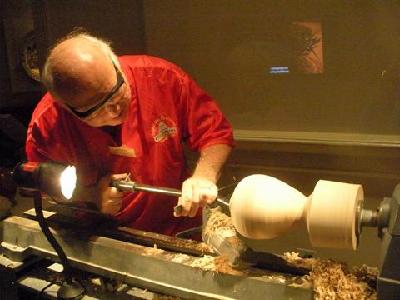
DOUG JOHNSON: Welcome to AMERICAN MOSAIC in VOA Special English.
(MUSIC)
I'm Doug Johnson.
This week we play music by Nora Jane Struthers.
And answer a question about Facebook.
But first we look at an exhibit in Washington that celebrates the art of wood turning and carving.
(MUSIC)
Revolution in Wood
DOUG JOHNSON: An exhibit at the Smithsonian's Renwick Gallery in Washington, DC is a celebration of the art of wood turning and carving. The exhibit is called "A Revolution in Wood: The Bresler Collection." Collectors Charles and Fleur Bresler donated all 66 works in the show to the museum. The many artists in the show have used their creativity and skill to turn this natural material into fine art. Mario Ritter has more.
MARIO RITTER: The "Revolution in Wood" exhibit shows a wide range of artistic expressions. Some works in the show are very large, such as Michelle Holzapfel's piece "Table Bracelet: Promenade Suite." The artist decided she wanted to make jewelry for the home, instead of for the body.
So she made this large movable piece that can be placed on a table. It contains three vases for holding flowers, three containers and two candle holders. The maple, birch, and cherry woods give each detail a different effect.
Other works are very small treasures. Janel Jacobson's "Coiled Snake" is made from a yellow-colored wood called boxwood. This very small and finely cut snake could fit in the palm of your hand.
Many of the works are containers, like the smooth form of a large bowl by Barry Macdonald. A vase by Brenda Behrens is made out of myrtle wood. Part of the vase is carved to look like a lotus plant.
Other works are more sculptural. Todd Hoyer's "Sphere" looks like a wooden planet. Mark Sfirri has a work called "Rejects from the Bat Factory." It looks like five wildly formed baseball bats hanging from a holder. The work was influenced by Mr. Sfirri's son who requested a home-made baseball bat. The artist realized that this form could be a great way to experiment with new shapes and cutting methods on his lathe machine.
In fact, many of the works in the exhibit were made on a lathe. A wood expert uses this machine to turn a wooden form. He or she uses a tool such as a gouge to slowly cut away at the form.
People have used lathes for centuries to make furniture and other objects. But it is only since the 1940s that the machine began to be used as a way to create art.
There is even a lathe set up near the exhibit area. About twice a week, artists show visitors how they use the lathe to create a turned wood bowl.
(SOUND)
Fleur Bresler says seeing art at the Renwick Gallery helped her discover her love of wood. She says the goal of the exhibit is to increase public awareness about the great value and skill of works made by wood artists.
DOUG JOHNSON: Our listener question this week comes from Daisy in China. She wants to know the history of Facebook. Friends, family, and co-workers use Facebook to communicate with each other. Many businesses use the site to show their products.
Users can write about themselves or their companies and include pictures and videos. They can also permit everyone, or only a few people, to see their Facebook pages.

This past summer, Facebook announced that it has over 500 million active users around the world. About half of them use the site every day. About 70 percent of all Facebook users are in countries outside the United States.
Mark Zuckerberg and three friends started Facebook in 2004. He was a second year student at Harvard University in Massachusetts. He began the project by illegally using the university's computer system. Harvard University charged him with violating several laws. Mr. Zuckerberg was almost forced to leave school. But the university withdrew the charges. Mark Zuckerberg was also accused of stealing other people's ideas and using them in Facebook. He has denied the charges. Several people have taken legal action against him.
At first, only Harvard students could use Facebook. But it quickly expanded to other universities. The website was also opened to high school students. Now, anyone at least 13 years old with an e-mail address can join.
In the early days, only a small group of people managed Facebook. Now it has over 1,700 workers in 12 countries.
Facebook makes money by selling advertising. It has been extremely successful. The financial company Second Market, Incorporated, says Facebook is worth 41 billion dollars.
A movie about the creation of Facebook, called "The Social Network", was released in October.
We also had a question from Vietnam. Van Nguyen wants to know about the life of civil rights leader Martin Luther King, Junior.
Monday is the national holiday that celebrates the life of the civil rights leader. You can hear about Dr. King and a memorial being built to honor him on the Special English program "This is America" on Monday.
Nora Jane Struthers
DOUG JOHNSON: Nora Jane Struthers describes her music as "classic Americana." Her songs are heavily influenced by bluegrass and folk music. Her first album performing alone is called "Nora Jane Struthers." The 26-year-old performs songs that sound like they came from another century. She says her earlier career as a teacher had a big influence on some of her songwriting. Barbara Klein tells us more.
(Music)

BARBARA KLEIN: That was Nora Jane Struthers singing "Greenbriar County." Struthers is not from the state she sings about, West Virginia, although her music may sound like it.
She grew up in New Jersey performing with her father Alan who is a blue grass musician. She says she learned music in the same way that folk and traditional music has been learned for ages -- by playing and singing with family members. She started writing her own songs in high school and performed in college. She later recorded an album with her father.
Here is the song "Willie" from Nora Jane Struthers' own album. It tells about a love story with a tragic ending.
(Music)
Struthers began her career teaching high school English in the Brooklyn area of New York City. She says she read many works by great English writers including William Shakespeare and Jane Austen. The universal subjects in their stories started to come out in the music she was writing.
In 2008, Nora Jane Struthers decided to work on her music career full time. She left New York and moved to Nashville, Tennessee.
We leave you with the lively sound of "Mocking Bird."
(Music)
DOUG JOHNSON: I'm Doug Johnson. Our program was written by Dana Demange and Jim Tedder. Caty Weaver was our producer.
Join us again next week for AMERICAN MOSAIC, VOA's radio magazine in Special English.
boxwood: 黄杨木
myrtle: a bush with shiny leaves, pink or white flowers and bluish-black berries 爱神木;香桃木;番樱桃
lathe: a machine that shapes pieces of wood or metal by holding and turning them against a fixed cutting tool 车床
Americana: things connected with the US that are thought to be typical of it 典型美国事物
bluegrass: a type of traditional American country music played on guitars and banjos 蓝草音乐(美国传统乡村音乐,用吉他和班卓琴演奏)
As the world turns: exploring the art of wood
Facebook's new friends like the world of private finance
Facebook film tops Golden Globes
Top 2010 American Roots music highlights
(来源:VOA 编辑:崔旭燕)
